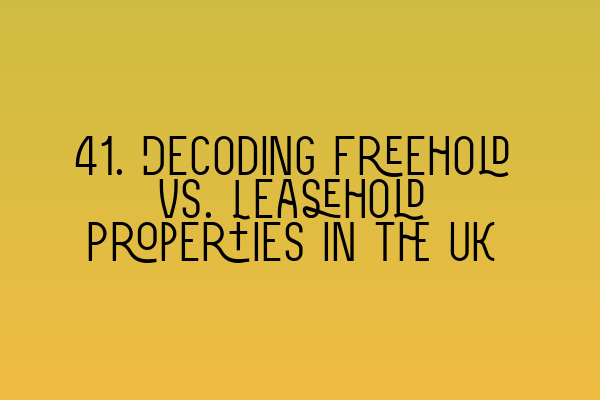Decoding Freehold vs. Leasehold Properties in the UK
When it comes to purchasing a property in the UK, one of the key considerations that often confuses potential buyers is the distinction between freehold and leasehold properties. Understanding the differences between these two types of ownership is crucial to ensure that you make an informed decision when investing in real estate. In this blog post, we will decode freehold and leasehold properties, highlighting their key features and implications.
Freehold Properties: True Ownership
Let’s begin with freehold properties, which represent the most common form of property ownership in the UK. A freehold property grants the buyer complete ownership rights to both the property and the land it stands on. This means that you have full control over your property, including the ability to make alterations, renovations, or extensions without needing permission from any additional parties.
One of the most enticing advantages of owning a freehold property is the absence of ground rent or service charges. Unlike leasehold properties, where you are required to pay regular fees to the landowner or freeholder, with a freehold property, you are free from any such financial obligations, making it a highly attractive option for homeowners.
Additionally, freehold properties provide greater security and stability as they are not subject to lease terms or expiration dates. This means that you can enjoy your property without the worry of lease extensions or renegotiations, providing you with peace of mind for the long term.
Leasehold Properties: Limited Ownership
On the other hand, leasehold properties represent a different form of ownership. In this case, you buy the right to occupy the property for a specific period of time, but the land itself remains owned by a freeholder or a landlord. Leasehold properties are usually common in situations such as apartments, flats, or properties in managed estates.
The leasehold agreement sets out the terms and conditions under which you can occupy the property. It outlines the duration of the lease, typically ranging from 99 years to 125 years or even longer. It is important to note that as the lease approaches its expiration, the value of the property may decline, making it less attractive to potential buyers.
Leasehold properties are subject to ground rent, which is an annual fee payable to the freeholder. Additionally, service charges may be levied for the upkeep and maintenance of communal areas or services. It is essential to consider these ongoing expenses when purchasing a leasehold property to avoid any financial surprises or unexpected costs.
Leasehold properties also come with certain limitations on alterations or modifications. Any changes made to the property may require the permission of the freeholder or the management company, which can cause delays and incur additional costs.
Making the Right Choice
Now that you understand the basics of freehold and leasehold properties, you may be wondering which option is the best for you. The choice ultimately depends on your personal circumstances and preferences.
If you value full control, independence, and long-term financial security, a freehold property would be the ideal choice. You are not bound by any lease terms or restrictions, and you have the freedom to make changes to the property as you see fit.
On the other hand, if you are looking for a more affordable option or are interested in living in a shared building or a managed estate, a leasehold property might be more suitable. However, it is crucial to carefully review the terms of the lease and consider the potential financial implications before making a decision.
Conclusion
In summary, freehold and leasehold properties have distinct characteristics and implications. While freehold properties offer complete ownership and control, leasehold properties come with certain limitations and ongoing financial obligations.
Understanding the differences between these two types of ownership is essential for anyone considering purchasing a property in the UK. By considering your personal circumstances, budget, and long-term goals, you can make an informed decision that aligns with your needs and preferences.
If you require further assistance or advice on property law matters, SQE Property Law & Land Law is here to help. Our team of experienced solicitors can provide expert guidance and support throughout the legal process. Contact us today to schedule a consultation.
Related Articles:
– Unsure about how to prepare for your SQE 1 exams? Check out our SQE 1 Practice Exam Questions for comprehensive study materials.
– Need more practice for your SQE 1 mocks? Take advantage of our SQE 1 Practice Mocks FLK1 FLK2 to refine your skills.
– Get prepared for your SQE 2 exams with our SQE 2 Preparation Courses, designed to help you succeed.
– Looking for comprehensive preparation for your SQE 1 exams? Explore our SQE 1 Preparation Courses to boost your confidence.
– Stay updated with the latest SRA SQE Exam Dates by visiting our website regularly to ensure you never miss an important deadline.
Note: SQE Property Law & Land Law is not responsible for the content of external websites. These links are provided for informational purposes only.
